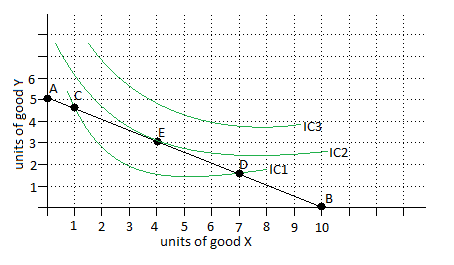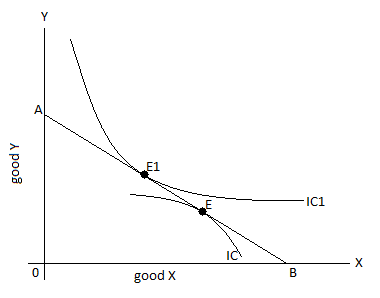Consumer’s Equilibrium
The consumer is in equilibrium when he maximizes his utility, given his income and the market prices.
– Anna Koutsoyiannis
Every consumer aims at getting maximum satisfaction out of his given expenditure. A consumer is said to have attained equilibrium when he spends given income or budget in such a way as to yield optimum satisfaction, given the prices of two goods and the consumer’s preference.
In simple words, a consumer is said to be in equilibrium when he is getting maximum satisfaction out of his limited income.
A consumer may find out his equilibrium condition with the help of indifference curve analysis.
Assumptions
Consumer’s equilibrium through indifference curve analysis is based on the following assumptions.
- The consumer is rational and seeks to maximize his satisfaction through the purchase of goods.
- The consumer consumes only two goods (X and Y).
- The goods are homogenous and perfectly divisible.
- Prices of the goods and income of the consumer are constant.
- The indifference map for goods X and Y are given. The indifference map is based on the consumer’s preferences for the goods.
- The preference or habit of the consumer does not change throughout the analysis.
- The income of consumer is given and constant.
Conditions of Consumer’s Equilibrium
The following are the conditions of consumer’s equilibrium
- Budget line should be tangent to the indifference curve
- At the point of equilibrium, slope of the budget line = slope of the indifference curve
- Indifference curve should be convex to the point of origin.
1. Budget line should be tangent to the indifference curve
Consumer’s equilibrium is based on the assumption that the income of a consumer is constant and that he spends his entire income on purchasing two goods whose prices are given.
A budget line is a graphical representation of various combinations of two goods that a consumer can afford at specified prices of the products at particular income level. A budget line can be drawn on the basis of expenditure plan.
The table given below is an example of expenditure plan and the graph that follows is its presentation on graph.
Table: Expenditure plan
| Given: Budget of the consumer is Rs 10, Price of good X is Rs 1 each and Price of good Y is Rs 2 each | ||
| Combination | Units of good Y | Units of good X |
| A | 5 | 0 |
| C | 4.5 | 1 |
| E | 3 | 4 |
| D | 1.5 | 7 |
| B | 0 | 10 |
Figure: Interplay of budget line and indifference curves

In the given diagram, we can see IC1, IC2 and IC3 are three different indifference curves and AB is a budget line. A consumer can only consume such combinations of goods which lie upon the budget line at a given income level and constant price of goods X and Y.
Since, we have,
level of income = Rs 10
price of good X = Rs 1
price of good Y = Rs 2
a consumer can only purchase goods in combination which satisfies the given equation “I = PX X QX + PY X QY” or “10 = 1 X QX+ 2 X QY”
At point A, 0 X 1 + 5 X 2 = 10
At point C, 4.5 X 2 + 1 X 1 = 10
At point E, 3 X 2 + 4 X 1 = 10
At point D, 1.5 X 2 + 7 X 1 = 10
At point B, 0 X 2 + 10 X 1 = 10
Thus, all these points lie on the budget line AB.
By the property of indifference curves, we know,
utility in IC3 > utility in IC2 > utility in IC1
A consumer can have any combination of goods that lie on the budget line except for the combinations A and B because in either case he would only have X or Y.
The consumer can purchase combinations C or D but these will not yield him maximum satisfaction as they lie on lower indifference curve. On the other hand, he cannot get any combination on IC3 as it is away from the budget line.
Thus, the consumer will be in equilibrium (achieve maximum satisfaction at any given level of income) where the budget line is tangent to the indifference curve, i.e. at point E on IC2.
2. At the point of equilibrium, the slope on indifference curve = slope of the budget line.
At any given point on the budget line,
![]()
For example, at point E, the slope of budget line = intercept on y-axis / intercept on x-axis
or, slope of budget line at point E = 3/6 = 1/2
The slope is 1/2 throughout the budget line.
From condition 1, we have known that consumer’s equilibrium exist at the point on indifference curve where budget line is tangent to the curve.
Thus, at equilibrium point, slope of budget line is equal to slope of the indifference curve.
3. Indifference curve should be convex to the point of origin
The other condition of equilibrium is that at the point of equilibrium, indifference curve should be convex to the origin. It means that marginal substitution rate between X and Y (MRSXY) should be diminishing. If indifference curve is concave and not convex to the origin, then it will not be the point of equilibrium.

In the above figure, AB is a budget line tangent to IC curve at point E.
At point E, marginal rate of substitution is increasing instead of diminishing. It means, by moving left or right of point E, a consumer can obtain higher amount of either good X or good Y. Thus point E is not an equilibrium point.
A consumer will therefore be in equilibrium when at the point of tangency of indifference curve and the budget line, the indifference curve is convex to the origin.
As shown in the above figure, a consumer is in equilibrium at point E1 where budget line AB is tangent to the indifference curve IC1 which is convex to the origin.
